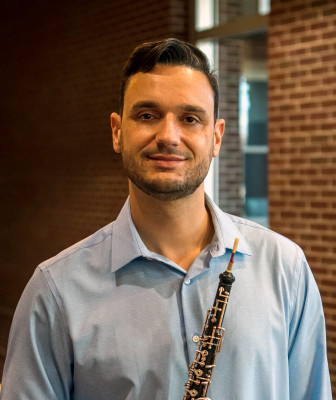Studio Overview
Oboe students become familiar with the standard repertoire, both solo and orchestral, and are also encouraged to explore new and/or unusual works and participate in chamber music performance. Study of the English horn and its literature is also an option.
Oboe graduates from CSU will leave as literate musicians, familiar with standard repertoire, orchestral excerpts, reed making, and problem-solving skills that allow the preparation of a continuingly growing repertoire. Fundamentals of efficient and healthy finger technique and posture are also emphasized, as are basic musicianship skills such as rhythmic accuracy, phrasing, and applying music theory to performance.
The double reed program at CSU provides students with plentiful opportunities to interact with eminent guest artists. The oboe student is a thinker first, a musician second, and an oboe player third. Professor Dos Santos Hernandez strives to make skills learned in the studio applicable to all other areas of activity, both musically and in the broader world. His teaching philosophy is to make himself obsolete and give students the critical listening problem-solving, and attention-to-detail skills that will help them become their own lifelong teachers, working toward their professional aspirations.
Oboe students have access to a well-equipped reed room with gouging and profiling machines, shapers, tube cane, and other tools necessary for creating reeds. Reed-making is part of the lesson curriculum, and time is set aside each week for reed assistance. Lessons incorporate the analysis of recordings of students’ playing, with slow-motion playback that enables faster growth of critical listening skills. Additional technology use includes slow-motion play along with professional recordings, virtual accompaniments, and reed analysis under magnification.
Regardless of major, CSU oboe students are encouraged to grow as thinking, self-evaluative musicians. The instrument is merely a voice that is controlled by musical understanding, attention to detail, critical and logical thinking, and a methodical approach to achieving a complex task. This understanding can be applied not only to oboe but to other areas of musical concentration, as well as endeavors beyond the musical realm. Without the joy of making music, it is difficult to stay interested and motivated, and students should never go without the wonderful experience of "I understand."
Study With
Audition Requirements
Undergraduate Auditions (all degrees)
- Two contrasting works
- Scales, all major scales with arpeggios, and minor scales in preferably the Harmonic form
- Sight Reading
- Suggested Etude Books: Ferling 48 Studiesand Barret40 Progressive Melodiesor 15 Grand Studies
Suggested Standard Literature:
- Albinoni Concerto
- Handel Sonata
- Mozart Concerto
- Poulenc Sonata
- Telemann Sonata or Partita
Graduate Auditions
- All major and minor scales
- Sight reading
- Two or three contrasting works displaying prospective student’s abilities. Applicant may select from repertoire suitable for a senior recital. Some examples of appropriate literature include:
- Mozart's Concerto in C
- Marcello's Concerto in C or D
- Britten's Six Metamorphosis
- Poulenc's Sonata for Oboe
- St. Saens' Sonata for Oboe
Past Guest Artists
- Nancy Ambrose King, University of Michigan and past president of the International Double Reed Society.
- Rebecca Henderson, Butler School of Music, University of Texas at Austin (Emeritus)
- Joseph Robinson, retired principal oboist of the New York Philharmonic, Conservatory of Music, Lynn University
- Eric Barr, Dallas Symphony Orchestra


